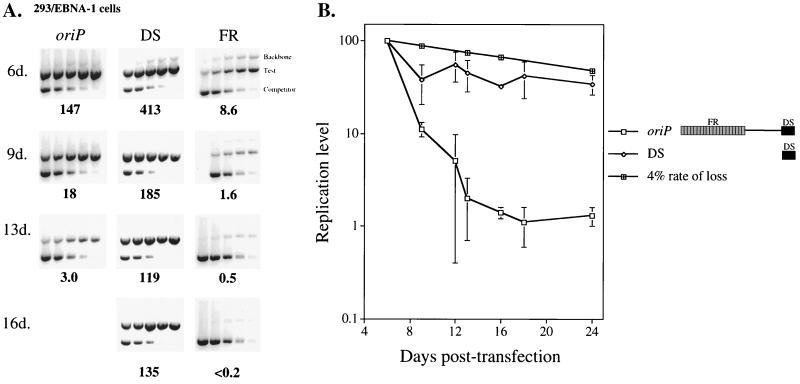FIG. 3.
(A) Plasmid containing only the DS of oriP supports efficient replication over 16 days posttransfection in 293/EBNA-1 cells, while replicated oriP plasmids are lost precipitously. Equimolar amounts of an oriP test plasmid (oriP), a test plasmid containing only the DS of oriP (DS), and a test plasmid lacking the DS of oriP (FR) were introduced independently into 293/EBNA-1 cells together with a prokaryotic backbone plasmid (Backbone). At the indicated times posttransfection, plasmid DNA was isolated by Hirt extraction and digested with XhoI and DpnI, and the level of replicated, DpnI-resistant DNA was determined by quantitative competitive PCR. PCRs were performed using 105 cell equivalents and a competitor DNA standard curve (9 pg, 3 pg, 600 fg, 120 fg, and 24 fg), except for the day 9 time point (9d.) for the FR experiment, in which 9 pg of competitor was not used. Numbers below each gel refer to the average number of molecules present per transfected cell for each test plasmid (oriP, DS, and FR). The amount of replicated oriP plasmid present at 6 days posttransfection and the amount of replicated DS plasmid present at each time point were quantified from separate gels in which 3.3 × 103 cell equivalents were assayed. The amount of replicated backbone plasmid detected at 6 days posttransfection in the oriP, DS, and FR experiments was 3.0, 3.6, and 0.8 molecules per transfected cell, respectively, and was undetectable at the latter times (<0.2 molecule/transfected cell). The 16-day time point for the oriP test plasmid is not shown because the cells were lost to contamination after the day 13 harvest. (B) DS plasmids are stable during 24 days posttransfection in 293/EBNA-1 cells, while oriP plasmids are lost precipitously. Shown is a graphic representation of experiments conducted as described above. The replication level of each plasmid was plotted versus the days posttransfection. For each independent experiment, the level of replicated test plasmid detected at 6 days posttransfection was set to 100% and the replication level at later time points was set relative to this point (100% = 439 ± 251 oriP and 754 ± 324 DS molecules per transfected cell). The data points are representative of the number of independent experiments listed: 6 days, n = 7; 9 days, n = 3; 12 days, n = 4; 13 days, n = 3; 16 days, n = 2; 18 days, n = 4; 24 days, n = 4. Three experiments in which the replication of the oriP test plasmid was monitored at 6, 9, 13, and 16 days posttransfection were presented previously (37). Note that the level of replicated oriP plasmid decreased approximately 100-fold from the cell population between 6 and 18 days posttransfection, then remained stable between 18 and 24 days. This finding is consistent with our previous observation that oriP plasmids are established in only 1% of transfected 293 cells (37). The 4% rate-of-loss curve, depicted by black cross-hatched boxes, is theoretical and is based on previous studies of established, drug-resistant cell clones (29, 56).

